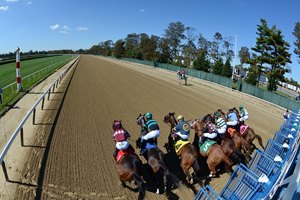NY Commission Passes Clenbuterol, NSAIDs Restrictions


The New York State Gaming Commission passed a series of rule adoptions and revisions aimed to control the improper use of clenbuterol and restrict the use of non-steroidal anti-inflammatory drugs in Thoroughbred racing, among other medication regulations, at its Nov. 30 meeting.
Clenbuterol, which is approved for the use in horses to treat lower airway disease, has been found to build muscle and has been used as a performance enhancer in racehorses. The commission allows the therapeutic use of the bronchodilator, but its rules state a horse cannot race for at least 14 days after administration, which is required to have a prescription from a veterinarian and be recorded in vet records.
Under the new rules, in order for a horse to be administered clenbuterol a written regulatory approval from the commission's equine medical director Dr. Scott Palmer. Also required would be the daily submission of any clenbuterol treatment and the placement of a horse on the vet's list if treated. A horse would not be able to return to racing until after testing negative for clenbuterol in both blood and urine samples.
Earlier this month Palmer noted that testing of nearly 100 Thoroughbreds previously with trainers federally indicted in March on performance-enhancing drug charges revealed that 77% showed presence of clenbuterol.
The commission's approved proposal comes about a month after the Mid-Atlantic Plan to Reduce Equine Fatalities announced the use of clenbuterol would face added restrictions in the region.
The commission also voted in favor of restricting the administration of NSAIDS to only one clinical dose the week before a horse races, with administration limited to intravenous treatment. The proposal calls to adopt stricter thresholds for the two most commonly used NSAIDS, flunixin and phenalbutazone, as is recommended by the Racing Medication and Testing Consortium, and adopted as a model rule by the Association of Racing Commissioners International.
Current rules permit the use of two NSAIDS from a list of six allowed the week before a race if one is not used within 96 hours of the race, and the other is administered outside 48 hours. The proposal reduces the list of NSAIDs that can be administered lawfully a week out from a race to only three by eliminating NSAIDS that are not widely used and for which the appropriate laboratory threshold is unclear.
The commission passed a rule that would remove certain penal aspects of horses coming off and returning to furosemide, commonly known as lasix, administration. New York's current rules allow horses to be removed from the lasix administration list, but only allows them to return to the list after a bleeding incident and mandatory layoff. The commission staff noted it felt the current rule may reduce trainers' willingness to experiment in running their horses without lasix.
The new proposed rule would allow a horse to be removed from the lasix-eligible list for the purpose of competing in a non-lasix race and allow the horse to return to the list without a mandatory layoff. The proposal received a comment from the New York Racing Association, which indicated its support for the proposal's adoption.
The commission also moved to strengthen regulations related to exercise induced pulmonary hemorrhage, passing a rule that will require trainers to maintain a record of serious EIPH episodes, or epistaxis (visible bleeding from the nostrils). A trainer would have to maintain the files for four years, unless given to a subsequent trainer or owner or reported to the commission, which under the new rule would establish a recording system for this information. Trainers may delegate their treating veterinarian for reporting.
The EIPH proposal would require a horse that experienced a serious EIPH episode to undergo another endoscopic exam after their next race or workout. Trainers would be required to provide EIPH information to subsequent owners or their agents or trainers within 48 hours of request for information unless the commission has already done so.
NYRA also commented on the EIPH proposal, stating that while it's important to be objective to the proposed rule and objective to the proposal as written, they believe the proposal lacks an enforcement mechanism.

Other passed proposals included the requirement of Thoroughbred trainers to keep a record of medications administered by the trainer after having been dispensed by veterinarians, exempting anti-ulcer medications commonly added to feed and other non-injectable drugs considered harmless by the ARCI. The commission also voted to amend its out-of-competition testing rule to conform to the ARCI's that would authorize a program that protects the constitutional rights of horse owners and trainers when a regulatory jurisdiction wants to collect a test sample.
The commission also sought to strengthen health and fitness protections and licensing requirements for jockeys, apprentice jockeys, exercise riders, and outriders in Thoroughbred racing and steeplechasing. A key part of the passed proposal would require every rider to document their baseline concussion status to undergo a sports concussion assessment tool examination after a fall or possible head injury.
